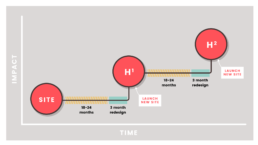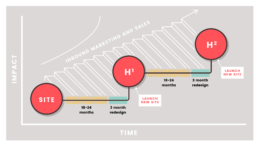You don’t run your business without evaluating and evolving. In fact, you’re where you’re at because you’ve shown a knack for being flexible and responsive to the needs of your customers. So why blow your budget and waste a year of your life one a website that won’t evolve with you? Your site should grow with your company, it should be a living tool that serves your needs today and 10 years from now.
At SeaMonster Studios, we’re helping clients get their vision out the door for the world to see. And then we’re working to keep it fresh, keep it relevant, and keep it growing.
We’re talking about Growth-Driven Design. The gist is pretty simple: start with asking the right questions, build a strategy around our goals, and prioritize where we put our time and budget. The result is a fast, lean website launch — getting your story, products, and presence online and in front of real audiences in a fraction of the time of a traditional launch. From there, we look at how the real world engages with the site, we listen to feedback and measure behavior and start working our way through the rest of our priority and wish lists. Instead of the static brochure site that can’t stay current with your dynamic, evolving business, you get a living, breathing website that adapts to the needs of your business and your customers.
- Starting small, with an iterative strategy that keeps long-term goals in mind.
- Modular design - thinking in flexible concepts that allow to expand or build without burning down or throwing away.
- Content-focused design isn’t just about how it looks — it’s about what it says and how it moves customers down the funnel.
- Learn - grow - learn - grow — it’s about setting yourself up for growing and iterating based on your results, your customer response, your shifting business strategies.
Out with the Old
While there’s a time and place for a traditional web design approach, in some cases, it can be frustrating and disappointing for lots of companies. It starts with so much anticipation and excitement — you have a vision for what’s possible, hire an agency that does great work, and cut a big check.
Problem is, you don’t know what you don’t know, and as things progress, you learn a lot about your company and you start to know those things. You realize that lots of assumptions go into making a website — what your customers want, what your team wants, what you want, what your agency can do with a budget. As the calendar turns and pages come to life, you begin to understand how much content there really is, and how busy your people really are, and could we try a new color on that page, or what about a customer portal, or can the whole thing be animated? Suddenly, the website has ballooned out of control and a bunch of money is in play and it’s gotta be perfect for launch.
Six months later, you may or may not be launching, and you’re probably asking: isn’t there a better way?
Traditional Web Design

Plan. Consider what the perfect site looks like: pages, products, marketing needs, customer service needs, product and engineering needs, content, functionality, mobile-friendly, SEO triumphant.
Design. Review page after page, looking at new designs with placeholder copy. As new pages roll out, new needs emerge, from content to something someone in some long forgotten department pointed out.
Build. The site begins to take shape, living on a server, hiding from your customers.
Content. Copy deadlines keep passing by, slowing down the development team. As copy arrives, page designs need to change to accommodate two more paragraphs and three more images. Oh, and that bulleted list.
Build, again. More code gets pushed, almost there.
Test. Debugging, focus groups, usability testing, device testing, accessibility testing…
Launch. You got what you wanted several months ago — but you’ve got a hot new product or new approach to your service, and the site just doesn’t quite fit anymore. The sales team isn’t happy with the results, and you’re wondering what it’ll cost to rebuild.
Growth Driven Design

Start with a solid base. We’ll work with you to understand your goals, needs, and wishes to build a rock-solid strategy that will inform every corner of your website
Prioritize. Our teams will list out the must-haves for launch, keeping in mind that the goal isn’t a day-one dream site, but something that meets primary needs and can grow to hit all the right notes. This doesn’t sacrifice quality, instead it puts guardrails on what’s absolutely required to go public and couches certain assumptions about what’s important so that we can see how visitors actually behave.
Launch. Let’s get the base site out the door — launched on-budget and on-time.
Iterate. We’ll be evaluating site performance, getting real-life feedback from real-life customers, and poring over data to make good decisions that are aligned with our overall strategy. Simultaneously, we’ll be working our way down the priority lists, expanding and evolving the site as it lives and breathes.
For us at SeaMonster Studios, Growth-Driven Design is about getting your site into the world quickly and intelligently, while also growing and honing content, depth, and functionality based on real-world input. Your business keeps growing, shouldn’t your website have a shot too?
Sign up for a free consultation and let’s look at how Growth-Driven Design can help your business grow.

